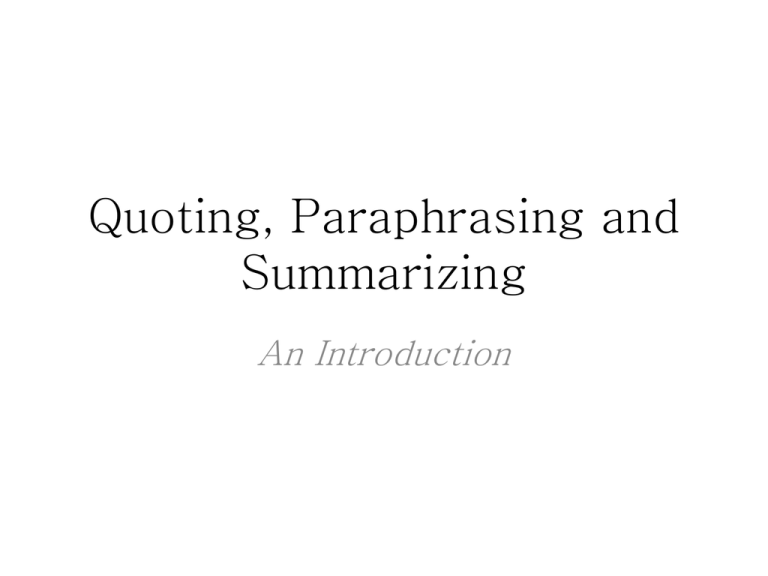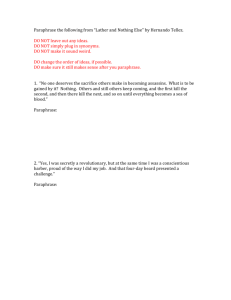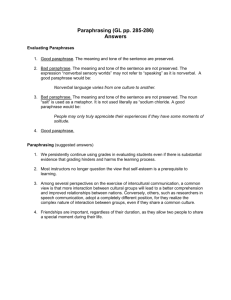1 - researchpapersession13
advertisement

Quoting, Paraphrasing and Summarizing An Introduction What’s the difference? • Quotations must be identical to the original. They must match the source document word for word and must be attributed to the original author. • Paraphrasing: Paraphrasing is re-writing another writer’s words or ideas in your own words without altering the meaning. The paraphrase is about the same length as the original since the purpose is to rephrase without leaving out anything. Paraphrased material is usually shorter than the original passage, taking a somewhat broader segment of the source and condensing it slightly. • Summarizing involves putting the main idea(s) into your own words, including only the main point(s). Once again, it is necessary to attribute summarized ideas to the original source. Summaries are significantly shorter than the original and take a broad overview of the source material. Purpose is to include only the main points of the original work and to leave out the irrelevant. A summary is usually about one-third the size of the original. Why do we use them? • Paraphrasing and summarizing are both indispensable writing tools. They are both techniques of incorporating other writers’ works or ideas into your writing using your own words. Although a writer must always use his/her own ideas when writing, sometimes it becomes necessary to use other writers’ thoughts and concepts. This may be due to one or more of the following reasons: • To provide support to your own ideas • To give reasons of why you agree or disagree with something • To give depth to your writing • To refer to something that led to your ideas • To give a point of view which is different from yours • give examples of several points of view on a subject • highlight a particularly striking phrase, sentence, or passage by quoting the original Now when should you paraphrase and when should you summarize? • Paraphrase when: • You want to use another writer’s words without plagiarizing • You want to use another writer’s words without the use of quotes • The ideas of the other writer are more important than his/her style • You think that the words of the other writer are too difficult for your readers • Summarize when: • You want to identify only the main ideas of the writer • You want to give an overview of the topic (from several sources) • You want to simplify a complex argument • You want to condense the matter to suit your requirement Make sure to… • Cite them to avoid using others’ ideas and words without clearly acknowledging the source of that information. – To avoid plagiarism, you must give credit whenever you use: • another person’s idea, opinion, or theory; • any facts, statistics, graphs, drawings—any pieces of information—that are not common knowledge; • quotations of another person’s actual spoken or written words; or • paraphrase of another person’s spoken or written words. Example • Here’s the ORIGINAL text, from page 1 of Lizzie Borden: A Case Book of Family and Crime in the 1890s by Joyce Williams et al.: • The rise of industry, the growth of cities, and the expansion of the population were the three great developments of late nineteenth century American history. As new, larger, steam-powered factories became a feature of the American landscape in the East, they transformed farm hands into industrial laborers, and provided jobs for a rising tide of immigrants. With industry came urbanization the growth of large cities (like Fall River, Massachusetts, where the Bordens lived) which became the centers of production as well as of commerce and trade. Good or Bad? What do you think? • The increase of industry, the growth of cities, and the explosion of the population were three large factors of nineteenth century America. As steamdriven companies became more visible in the eastern part of the country, they changed farm hands into factory workers and provided jobs for the large wave of immigrants. With industry came the growth of large cities like Fall River where the Bordens lived which turned into centers of commerce and trade as well as production. That was a bad paraphrase WHY???? • The preceding passage is considered plagiarism for two reasons: • the writer has only changed around a few words and phrases, or changed the order of the original’s sentences. • the writer has failed to cite a source for any of the ideas or facts. • If you do either or both of these things, you are plagiarizing. NOTE: This paragraph is also problematic because it changes the sense of several sentences (for example, "steam-driven companies" in sentence two misses the original’s emphasis on factories). Good or Bad? • Here’s the ORIGINAL text, from page 1 of Lizzie Borden: A Case Book of Family and Crime in the 1890s by Joyce Williams et al.: • The rise of industry, the growth of cities, and the expansion of the population were the three great developments of late nineteenth century American history. As new, larger, steam-powered factories became a feature of the American landscape in the East, they transformed farm hands into industrial laborers, and provided jobs for a rising tide of immigrants. With industry came urbanization the growth of large cities (like Fall River, Massachusetts, where the Bordens lived) which became the centers of production as well as of commerce and trade • What do you think? Good or bad? Fall River, where the Borden family lived, was typical of northeastern industrial cities of the nineteenth century. Steam-powered production had shifted labor from agriculture to manufacturing, and as immigrants arrived in the US, they found work in these new factories. As a result, populations grew, and large urban areas arose. Fall River was one of these manufacturing and commercial centers (Williams, 2001). This was a good paraphrase WHY???? • This is acceptable paraphrasing because the writer: • accurately relays the information in the original uses her own words. • lets the reader know the source of his/her information. Questions?? Summarizing Steps to summarize • Record the author, title, year of publication and source of the text. • Skim the text. Note any sub-headings, or try to divide the text into sections. • Read the text carefully. Use a dictionary if necessary, and be prepared to read very difficult texts more than once. • Pay special attention to the first and last paragraphs. Try to identify the main idea or argument. • Identify the topic sentence in each paragraph. • Identify the main support for the topic sentence. • Write the topic sentence of your summary. Include the author’s name, the title of the text, the year of publication and the author’s main idea or argument But today let’s focus on paraphrasing • Three criteria for a good paraphrase • 1. It has the same meaning as the original (all main ideas included and no new idea added) • 2. Is different enough from the original to be considered your own writing. (Uses no more than four or five words in a row from the original source. Changes grammar and vocabulary as much as possible) • 3. refers directly to (or cites) the original source. (Include the name of the author and/or the name of the source. Paraphrasing 6 Steps to Effective Paraphrasing • 1. Reread the original passage until you understand its full meaning. • 2. Set the original aside, and write your paraphrase on a note card. • 3. Jot down a few words below your paraphrase to remind you later how you envision using this material. At the top of the note card, write a key word or phrase to indicate the subject of your paraphrase. • 4. Check your rendition with the original to make sure that your version accurately expresses all the essential information in a new form. • 5. Use quotation marks to identify any unique term or phraseology you have borrowed exactly from the source. • 6. Record the source (including the page) on your note card so that you can credit it easily if you decide to incorporate the material into your paper. Practical advice. - Change sentence structure - Change words (Thesaurus.com) – use words that you are familiar with. - Use an English-English dictionary to get some idea. (1)Now you try • Original: As the chain [McDonald’s] expanded nationwide in the mid-1960’s, it sought to cut labor costs, reduce the number of suppliers, and ensure that its fries tasted the same at every restaurant. – Scholosser, Eric, “Why McDonald’s Fries Taste So Good” 2002 • Paraphrase this on a separate sheet of paper…. Compare your paraphrases to this… • Schlosser (2002) writes that while McDonald’s spread all over the country during the 1960’s, the company tried to spend less on its workers, get its supplies from fewer sources, and guarantee that its French fries always tasted the same. (2)Try another one • Original: Many of the doctors taking part in the survey on assisted suicide doubted whether they could decide if a patient had less than six months to live. – “The Anguish of Doctors” 1996 • Your paraphrase: Compare this with your paraphrase • According to a survey on assisted suicide in The Anguish of Doctors (1996), many doctors disagree with assisted suicide because they can’t know when a patient will die. Another paraphrasing technique • “Tell a friend method” 1. Read the original and concentrate on what it means. 2. Cover the original so that you cannot see it. 3. Imagine you are talking to a good friend. How would you explain this idea to your friend? Write down your explanation. 4. Go back and reread the original to see if it means the same as your paraphrase. Let’s try • Original: Leadership by birth order apparently hold for both genders. Studies have found that female executives are much more likely to be firstborns that later-borns. – Koselka, Rita and Shook, Carrie, “Born to Rebel? Or Born to Conserve?” 1997 • Now, tell this to your partner. Compare your paraphrase with this • Not only firstborn men, but also firstborn women are more likely to be executives than people who are later born (Koselka & Shook, 1997). • Notice that while they key ideas from the original are included in the paraphrase, the structure of the paraphrase is very different. Another method: Chunking method (For longer passages) • 1. Read the original passage several times to develop a basic understanding of the ideas. • 2. Divide the passage into chunks by underlining main ideas. (As you divide the passage, focus on phrases rather than on individual words) • 3. Explain each chunk using your own words. • 4. Combine these explanations into one or more sentences to create a paraphrase. – As you combine these chunks, you will need to think about how the ideas are related to each other. – It is okay to rearrange these chunks into a new order for you paraphrase. • (1)As the chain , [McDonald’s] expanded nationwide, in the mid-1960’’s, (2) it sought to cut labor costs, (3) reduce the number of suppliers, and (4) ensure that its fries tasted the same at every restaurant. (5) McDonald’s began switching to frozen French fries in 1966-and (6) few customers noticed the difference. (7) Nevertheless, the change had a profound effect on the nation’s (8) agriculture and diet. –Scholosser, Eric, “Why McDonald’s Fries Taste So Good” 2002 Paraphrase each chunk one at a time. Compare your paraphrase to these paraphrased chunks 1. 2. 3. 4. McDonald’s spread all over the country during the 1960’s. The company tried to spend less on its workers. It got its supplies from fewer sources. It wanted to guarantee that its French fries always tasted the same. 5. The company started using frozen French fries. 6. Not many people realized the change had been made. 7. But using frozen fries ultimately had a big influence. 8. It influenced U.S. farming and eating habits. After you have divided them into chunks, you reword them in chunks. One at a time. Try this one. I divided this to 3 ch unks for you. (1) There is an element of sacrifice and obligation: women are expected to (2) make many things secondary (3) once the husband comes along, to devote their energies to him and his house and the building of another family Unit. - Wark, Penny, “What Does Life Tell Us About Love?” 2003 Compare your paraphrase to this one • 1. Women must give up time and energy for themselves. • 2. After women get married • 3. Women are expected to focus on taking care of their husband, home, and children. (2) After they get married, (1) women must give up time and energy for themselves because (3) they are expected to focus on taking care of their husband, home, and children (Wark, 2003). Notice the chunks have been arranged in an order that is different from the original. Now you try. • Original: Often procrastination stems from a real or imagined fear or worry that is focused not so much on the thing you are avoiding, but its potential consequences. – Moore, Rebecca; Baker, Barbara; Packer, Arnold, “coping With Procrastination” 1997





